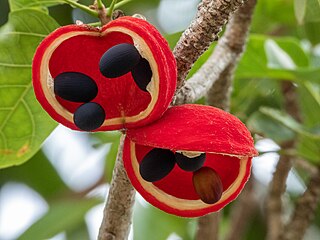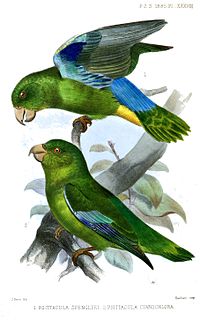
A vine is any plant with a growth habit of trailing or scandent stems, lianas or runners. The word vine can also refer to such stems or runners themselves, for instance, when used in wicker work.

Acer circinatum, the vine maple, is a species of maple native to western North America, from southwest British Columbia to northern California, usually within 300 kilometres (190 mi) of the Pacific Ocean coast, found along the Columbia Gorge and Coastal Forest. It belongs to the Palmatum group of maple trees native to East Asia with its closest relatives being the Acer japonicum and Acer pseudosieboldianum. It can be difficult to distinguish from these species in cultivation. It is the only member of the Palmatum group that resides outside of Asia.

Sterculia quadrifida, also known as the peanut tree, or red-fruited kurrajong is a small tree that grows in the rainforests, vine thickets, and gallery forests of New Guinea and northern Australia.

The green-crowned brilliant is a large, robust hummingbird that is a resident breeder in the highlands from Costa Rica to western Ecuador. It is also known as the green-fronted brilliant.

The dark long-tongued bat is a species of bat from South and Central America. It was formerly considered monotypic within the genus Lichonycteris, but is now recognized as one of two species in that genus, along with the pale brown long-nosed bat. It is small species of bat, with adults weighing 6–11 g (0.21–0.39 oz) and having a total length of 46–63 mm (1.8–2.5 in).

Thomas's nectar bat is a bat species from South and Central America. Thomas's nectar bat polinates marcgravia.

Helicia is a genus of 110 species of trees and shrubs, constituting part of the plant family Proteaceae. They grow naturally in rainforests throughout tropical South and Southeast Asia, including India, Sri Lanka, Indochina, Peninsular Malaysia to New Guinea and as far south as New South Wales.
Ipomoea chrysocalyx is a vine in the family Convolvulaceae. It is endemic to Ecuador. Its natural habitat is subtropical or tropical dry forests.
Marcgravia crassiflora is a species of flowering plant in the Marcgraviaceae family. It is endemic to Ecuador.

Marcgravia is a genus of plants in the Marcgraviaceae family commonly eaten by the dwarf little fruit bat the plant is native to the Caribbean Islands, Central America, and South America. The genus is named in memory of the German naturalist Georg Marcgraf. The plant is visited by Thomas's nectar bat.
Marcgravia grandifolia is a species of plant in the Marcgraviaceae family. It is endemic to Ecuador.
Marcgraviastrum gigantophyllum is a species of plant in the Marcgraviaceae family. It is endemic to Ecuador. The vine's natural habitat is subtropical or tropical moist montane areas of the Andes Ecuadorian ranges.
Miconia ascendens is a species of plant in the family Melastomataceae. It is a shrub, vine, or liana endemic to Ecuador. Its natural habitats are subtropical or tropical moist montane forests and subtropical or tropical high-altitude shrubland.
Passiflora ampullacea is a species of plant in the family Passifloraceae. The vine is endemic to Ecuador. It is an IUCN Red List threatened species.
Stigmaphyllon ecuadorense is a species of plant in the Malpighiaceae family. It is a vine endemic to Ecuador. Its natural habitat is subtropical or tropical moist lowland forests.
Stigmaphyllon eggersii is a species of plant in the Malpighiaceae family. It is a vine endemic to Ecuador. Its natural habitat is subtropical or tropical dry forests.
Marcgravia evenia is a species of flowering vine in the family Marcgraviaceae. Within this family it belongs to the Galetae group, which is characterized by a long inflorescence axis and boat shaped nectaries. The plant is endemic to Cuba.

The turquoise-winged parrotlet is a species of parrot in the family Pscittacidae.
Marcgravia rectiflora is a plant species native to Peru and Central America.
Marcgravia dressleri is a species of Marcgravia. Marcgravia dressleri is native to Colombia.









